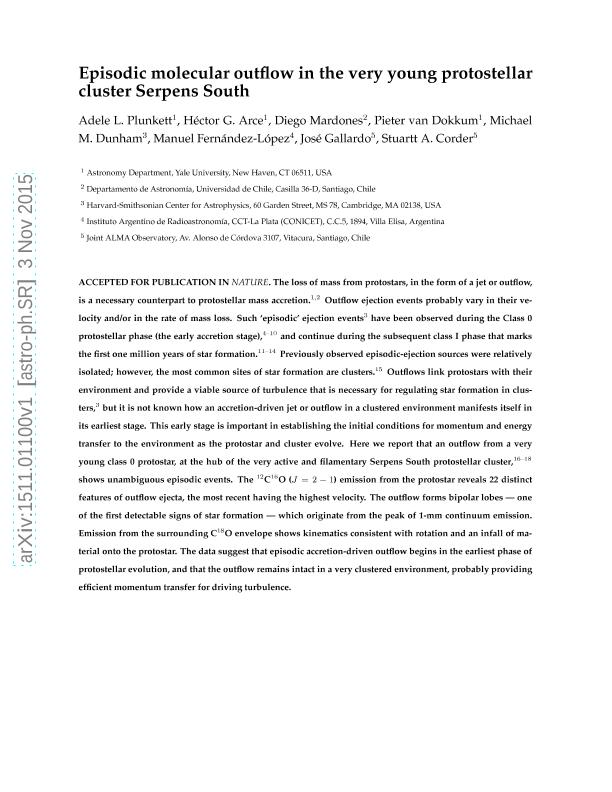Mostrar el registro sencillo del ítem
dc.contributor.author
Plunkett, Adele L.
dc.contributor.author
Arce, Héctor G.
dc.contributor.author
Mardones, Diego
dc.contributor.author
van Dokkum, Pieter
dc.contributor.author
Dunham, Michael M.
dc.contributor.author
Fernandez Lopez, Manuel

dc.contributor.author
Gallardo, José
dc.contributor.author
Cordero, Stuartt A.
dc.date.available
2016-10-19T17:14:23Z
dc.date.issued
2015-11
dc.identifier.citation
Plunkett, Adele L. ; Arce, Héctor G.; Mardones, Diego ; van Dokkum, Pieter ; Dunham, Michael M. ; et al.; Episodic molecular outflow in the very young protostellar cluster Serpens South; Nature Publishing Group; Nature; 527; 7576; 11-2015; 70–73
dc.identifier.issn
0028-0836
dc.identifier.uri
http://hdl.handle.net/11336/7730
dc.description.abstract
The loss of mass from protostars, in the form of a jet or outflow, is a necessary counterpart to protostellar mass accretion. Outflow ejection events probably vary in their velocity and/or in the rate of mass loss. Such `episodic´ ejection events have been observed during the Class 0 protostellar phase (the early accretion stage), and continue during the subsequent class I phase that marks the first one million years of star formation. Previously observed episodic-ejection sources were relatively isolated; however, the most common sites of star formation are clusters. Outflows link protostars with their environment and provide a viable source of turbulence that is necessary for regulating star formation in clusters, but it is not known how an accretion-driven jet or outflow in a clustered environment manifests itself in its earliest stage. This early stage is important in establishing the initial conditions for momentum and energy transfer to the environment as the protostar and cluster evolve. Here we report that an outflow from a very young class 0 protostar, at the hub of the very active and filamentary Serpens South protostellar cluster, shows unambiguous episodic events. The 12CO (J=2-1) emission from the protostar reveals 22 distinct features of outflow ejecta, the most recent having the highest velocity. The outflow forms bipolar lobes --- one of the first detectable signs of star formation --- which originate from the peak of 1-mm continuum emission. Emission from the surrounding C18O envelope shows kinematics consistent with rotation and an infall of material onto the protostar. The data suggest that episodic accretion-driven outflow begins in the earliest phase of protostellar evolution, and that the outflow remains intact in a very clustered environment, probably providing efficient momentum transfer for driving turbulence.
dc.format
application/pdf
dc.language.iso
eng
dc.publisher
Nature Publishing Group

dc.rights
info:eu-repo/semantics/openAccess
dc.rights.uri
https://creativecommons.org/licenses/by-nc-sa/2.5/ar/
dc.subject
Serpens South
dc.subject
Mass Loss
dc.subject
Protostars
dc.subject
Mass Accretion
dc.subject
Episodic Outflows
dc.subject
Pre-Main Sequence (Stars)
dc.subject.classification
Astronomía

dc.subject.classification
Ciencias Físicas

dc.subject.classification
CIENCIAS NATURALES Y EXACTAS

dc.title
Episodic molecular outflow in the very young protostellar cluster Serpens South
dc.type
info:eu-repo/semantics/article
dc.type
info:ar-repo/semantics/artículo
dc.type
info:eu-repo/semantics/publishedVersion
dc.date.updated
2016-09-19T18:37:29Z
dc.journal.volume
527
dc.journal.number
7576
dc.journal.pagination
70–73
dc.journal.pais
Reino Unido

dc.journal.ciudad
Londres
dc.description.fil
Fil: Plunkett, Adele L. . Yale University. Astronomy Department.; Estados Unidos
dc.description.fil
Fil: Arce, Héctor G.. Yale University. Astronomy Department.; Estados Unidos
dc.description.fil
Fil: Mardones, Diego . Universidad de Chile. Departamento de Astronomía; Chile
dc.description.fil
Fil: van Dokkum, Pieter . Yale University. Astronomy Department.; Estados Unidos
dc.description.fil
Fil: Dunham, Michael M. . Harvard-Smithsonian Center for Astrophysics; Estados Unidos
dc.description.fil
Fil: Fernandez Lopez, Manuel. Consejo Nacional de Investigaciones Científicas y Técnicas. Centro Científico Tecnológico La Plata. Instituto Argentino de Radioastronomia (i); Argentina
dc.description.fil
Fil: Gallardo, José. Joint ALMA Observatory; Chile
dc.description.fil
Fil: Cordero, Stuartt A. . Joint ALMA Observatory; Chile
dc.journal.title
Nature

dc.relation.alternativeid
info:eu-repo/semantics/altIdentifier/url/http://www.nature.com/nature/journal/v527/n7576/full/nature15702.html
dc.relation.alternativeid
info:eu-repo/semantics/altIdentifier/arxiv/http://arxiv.org/abs/1511.01100
Archivos asociados
